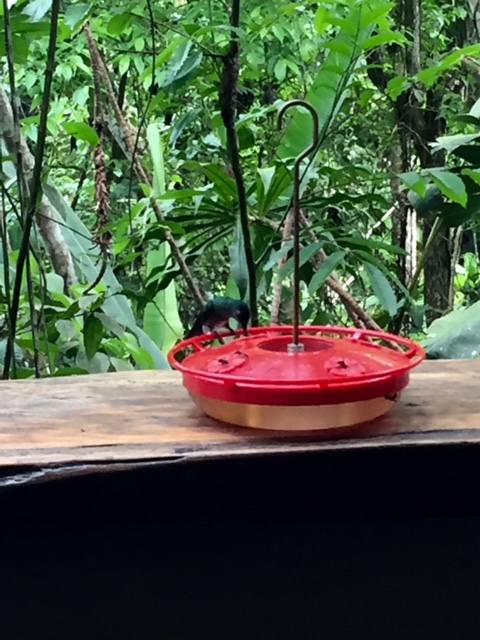During our second full day in Panama, the group traveled to Discovery Center and Pipeline Road, locations known for immense biological diversity. Among this biological diversity, many hummingbird species native to Panama can also be found. Today, our group saw multiple hummingbird species including the Long-billed Hermit, White Necked Jacobin, and White Vented Plumeleteer filling up at hanging nectar feeders along the trail.

The White-necked Jacobin can be seen approaching the feeder. These hummingbirds can be identified by their blue heads, iridescent feathers, and white bellies.

The Long-billed Hermit can be seen flying towards the nectar feeder. This species can be identified by its abnormally long beak, which is used to consume nectar.
The Long-billed Hermit, White Necked Jacobin, and White Vented Plumeleteer are only a few of the 320 different species of hummingbirds found throughout the Americas (“Hummingbird,” n.d.). The Neotropics are considered a “hotspot” for hummingbirds as approximately 60 species are found in Panama alone. Hummingbirds are known for their fast wing beats and have the ability to beat their wings up to 80 beats per second. This is done to help the hummingbird hover and move from flower to flower, collecting nectar with ease (“Why do,” n.d.). Additionally, these birds do not have a lot of strength in their lower bodies, so their wings act as a support structure (“Why do,” n.d.). The wing structure also allows the hummingbird to travel at a speed more than 15 m/s (“Hummingbird,” n.d.). While hummingbirds can travel at a fast speed, their wind speed takes a substantial amount of energy and in order to conserve energy, most hummingbirds spend their day sitting along branches to rest. At night, some species can even lower their internal body temperature and metabolic rate in an effort to conserve energy.
In addition to having a fast wind speed, hummingbirds have a fast breathing rate, elevated heartbeat, and relatively high internal body temperature, which requires them to eat frequently and in large quantities (“Basic Facts,” 2012). The diet of many hummingbirds includes: nectar from flowers, insects for some species, pollen, and even tree sap (“Basic Facts,” 2012). As hummingbirds must eat often, they can become very territorial over food sources and have been known to chase other hummingbird species or larger predatory birds such as hawks away from their food source.
This video shows two species of humming birds fighting over a nectar food source as hummingbirds can be territorial:
Hummingbirds are amazing species and need our help! Many of these birds are either endangered or threatened due to habitat loss and destruction since they are typically adapted to a unique habitat, meaning they can only live within this habitat. Additional threats of climate change are also affecting the species and causing hummingbirds to migrate to different locations they are not normally found in or adapted to live in (“Hummingbird,” n.d.).
References:
Basic Facts About Hummingbirds. (2012). Retrieved May 18, 2016, from
http://www.defenders.org/hummingbirds/basic-facts
Hummingbird. (n.d.). Retrieved May 18, 2016, from
http://www.onekind.org/education/animals_a_z/hummingbird
Why do hummingbirds flap their wings so quickly? (n.d.). Retrieved May 18, 2016, from
http://www.whyzz.com/why-do-hummingbirds-flap-their-wings-so-quickly2 hums fighting

